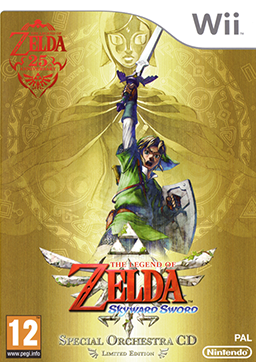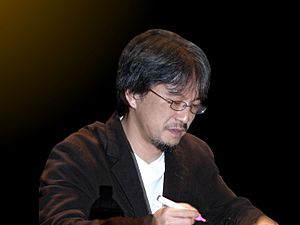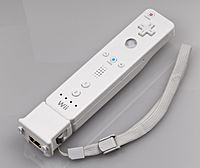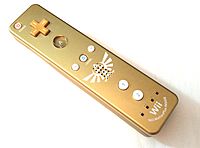The Legend of Zelda: Skyward Sword facts for kids
Quick facts for kids The Legend of Zelda: Skyward Sword |
|
|---|---|

European packaging artwork
|
|
| Developer(s) | Nintendo EAD |
| Publisher(s) | Nintendo |
| Director(s) | Hidemaro Fujibayashi |
| Producer(s) | Eiji Aonuma |
| Designer(s) | Ryuji Kobayashi |
| Programmer(s) |
|
| Artist(s) | Takumi Wada |
| Writer(s) |
|
| Composer(s) |
|
| Series | The Legend of Zelda |
| Platform(s) | Wii |
| Release date(s) | |
| Genre(s) | Action-adventure |
| Mode(s) | Single-player |
The Legend of Zelda: Skyward Sword is an action-adventure game made by Nintendo for the Wii console. It came out in 2011. A newer, improved version called The Legend of Zelda: Skyward Sword HD was released for the Nintendo Switch in July 2021.
In this game, you play as Link, the main hero of the Legend of Zelda series. You explore a floating island called Skyloft and the lands below it. Your main tasks are to complete quests and solve puzzles in the environment and in special areas called dungeons. The game uses the Wii MotionPlus accessory for its controls. This means you use your movements to control Link's sword and shield in battles.
Skyward Sword is important because it's the first game in the Zelda timeline. It tells the origin story of the Master Sword, a famous weapon in the series. Link lives in Skyloft, a town floating above the clouds. He goes on a journey to save his childhood friend, Zelda, after she is taken to the mysterious lands below.
Making the game took about five years, starting after Twilight Princess came out in 2006. Other Zelda games like Ocarina of Time and Majora's Mask also inspired the creators. The game's art style looks like paintings from artists such as Paul Cézanne. Using the Wii MotionPlus was tricky for the developers, but they made it work. This was also the first Zelda game to use a real orchestra for most of its music.
Skyward Sword was announced in 2009 and was supposed to be released in 2010. However, it was delayed to 2011 to make it even better. The game was a big success, getting high scores from many reviewers and selling millions of copies. The 2021 Switch version also sold very well. Ideas from Skyward Sword even helped shape the next big Zelda game, The Legend of Zelda: Breath of the Wild.
Contents
How to Play Skyward Sword

The Legend of Zelda: Skyward Sword is an action-adventure video game. You play as Link and explore different areas filled with monsters. You also go into dungeons that have puzzles and more enemies, including big bosses.
Using Your Wii Remote and Nunchuk
You control Link using the Wii Remote and Nunchuk. The Wii MotionPlus accessory is needed to play. Most of the game's controls use motion. For example, you move the Wii Remote to swing Link's sword. The Nunchuk helps you control the camera and Link's shield. Link can automatically jump over small gaps and climb ledges. You can also make Link roll forward with the Nunchuk.
Stamina and Sprinting
Link can sprint for short periods. Actions like sprinting, climbing, or carrying heavy items use up a stamina bar. This bar recharges quickly when Link isn't doing these actions. If the bar runs out, Link moves slower and is weaker until it refills.
Fighting Enemies
Fighting enemies involves Link's sword and shield. Your sword moves match how you flick the Wii Remote. You can also thrust or stab. Enemies are smart and will try to block your attacks. If you hold the Wii Remote up, Link's sword gathers energy for a "Skyward Strike." This move can also activate special switches in the environment. You use the Nunchuk to control Link's shield, which can block or reflect attacks. Link's health is shown by hearts. If he loses all hearts, the game ends.
Exploring the World
The game takes place on Skyloft, a floating island, and three main areas on the "Surface" below. You can find side quests in Skyloft and on the Surface. You reach the Surface areas through special light columns in the clouds. To travel in the sky, Link rides a large bird called a Loftwing. On the Surface, Link walks. You can set beacons on your map to help you find your way. Statues act as save points to save your game progress.
Fi, Your Guide
During your adventure, Link is helped by Fi. She is the spirit of the Goddess Sword. Fi can give you hints about puzzles or enemy weaknesses. For example, if you target an enemy, Fi can tell you how to defeat it.
Items and Upgrades
You'll find classic Zelda items like Bombs and the Bow and Arrow. There are also new items, like a mechanical Beetle that flies to hard-to-reach places. Some items, like shields, can break if used too much. You can upgrade your items and equipment. To do this, you need materials from defeated monsters and Rupees, which is the game's money.
The Story of Skyward Sword
Skyward Sword tells the very first story in the Zelda timeline. Long ago, three Goddesses gave a powerful wish-granting item called the Triforce. A Demon King named Demise tried to take the Triforce and destroyed much of the land. The Goddess Hylia saved the remaining people by sending them into the sky. She then fought Demise and won, but the land was badly damaged. Years later, the people of Skyloft believe the Surface below is just a myth.
Link's Adventure Begins
In the present, Link is a knight-in-training in Skyloft. He passes his final exam, even with his rival Groose trying to stop him. Groose also likes Link's childhood friend, Zelda. After the exam, Link and Zelda go for a celebratory flight. But a dark tornado pulls Zelda below the clouds.
Back on Skyloft, Link finds the Goddess Sword in Hylia's statue. Fi, the sword's spirit, appears and tells Link he is the hero meant to destroy Demise. Link opens a path through the clouds to the Surface. Fi guides him to the Sealed Temple, where he meets an old woman. She tells him to find Zelda.
Chasing Zelda and Meeting Villains
Link travels through Faron Woods, Eldin Volcano, and Lanayru Desert. He catches up to Zelda, but a young woman named Impa stops him from taking Zelda back to Skyloft. Impa is guiding and protecting Zelda. Link also meets Ghirahim, a self-proclaimed Demon Lord who wants to free Demise. At the Temple of Time, Link fights Ghirahim. This gives Zelda and Impa time to escape through a "Gate of Time" into the past. Impa destroys the gate behind them.
Battling Demise
Link returns to the Sealed Temple, and Groose follows him to the Surface. Link must defeat the Imprisoned, a monster form of Demise, who is trying to reach the temple. After defeating it, Link strengthens the Goddess Sword by passing trials and finding Sacred Flames. This awakens a second Gate of Time.
Link travels to the past and finds Zelda. He learns that Zelda is the human form of Goddess Hylia! Hylia couldn't defeat Demise forever, so she became mortal to find someone who could use the Triforce to destroy him. Only humans can use the Triforce. Zelda then seals herself in a crystal to make Demise's seal stronger. This also upgrades the Goddess Sword into the powerful Master Sword.
The Final Battle
Link finds the Triforce on Skyloft and uses it to destroy Demise. Zelda is freed, but Ghirahim kidnaps her. Ghirahim wants to use Zelda to bring Demise back to life in the past. Link chases Ghirahim into the past and defeats him. It turns out Ghirahim is the spirit of Demise's sword! But it's too late; Zelda is used to bring Demise back.
Groose protects Zelda while Link fights Demise. Link wins and traps Demise's evil spirit in the Master Sword. But before he's gone, Demise curses Link and Zelda's families, saying his hatred will always return. To seal the sword, Link places it in a pedestal in the Sealed Temple, and Fi goes into an eternal sleep.
Link, Zelda, and Groose return to their own time. Impa stays behind in the past to watch over the Master Sword. In the present, the old woman Link met earlier greets them one last time before disappearing. She was Impa all along! The game ends with the Surface now open to the people of Skyloft. Zelda decides to stay on the Surface to protect the Triforce. She and Link then create the kingdom of Hyrule.
Making the Game: Development Story

Work on Skyward Sword began in 2006, after The Legend of Zelda: Twilight Princess was released. The game was made by Nintendo Entertainment Analysis & Development, with help from Monolith Soft. Eiji Aonuma was the producer, and Hidemaro Fujibayashi was the director.
Starting Points and Challenges
The team wanted to build on Twilight Princess but also create a memorable experience like The Legend of Zelda: Ocarina of Time. Development took about five years, which was longer than planned. The first two years were spent trying out new ideas. By June 2011, the game was almost finished, just needing some final adjustments.
Creating the Story
The story was written by Naoki Mori, based on ideas from director Fujibayashi. They decided to make it an origin story for the Master Sword. It was tricky to make the story fit with other Zelda games. Fujibayashi wrote the main story outline in one day!
Link and Zelda's relationship is different here; they are childhood friends. This was done to make players care more about Zelda and want to rescue her. The character of Hylia was new, but she is linked to Zelda. Groose, Link's rival, was added to make the school setting more interesting. His growth in the story helps show Link's own journey.
Fi was designed to look like the Master Sword, as she is its spirit. She also helps explain things since Link doesn't speak. Ghirahim was made to be a clever enemy, similar to Dark Link from Ocarina of Time. He can read Link's moves, so you need to think carefully to beat him.
Art Style and Design
The game's art style uses warm colors and looks like brushstrokes. This was inspired by impressionist painters like Claude Monet and post-impressionist Paul Cézanne. The goal was to balance the cartoon look of The Legend of Zelda: The Wind Waker with the more realistic style of Twilight Princess. This allowed for fun, exaggerated actions while keeping Link looking mature.
Designing Gameplay with Wii MotionPlus
The developers wanted to make the game feel new while still being familiar. Using the Wii MotionPlus was a big change. It was so hard to get right that producer Aonuma almost decided to remove it! But after seeing how it worked in Wii Sports Resort, they figured out how to use it for sword fighting. This meant enemies had to be smarter, reacting to Link's sword position.
The "Skyward Strike" idea came from Aonuma thinking about holding the sword above Link. Using motion controls for sword fighting also freed up other buttons. This allowed for the "Dash" sprint option. The "Dowsing" mechanic, which helps you find things, was added early on. This meant they didn't need as many obvious landmarks in the world.
The team decided to have only three main Surface areas but made them very detailed. This encouraged players to explore them many times. The Skyloft area was created because it was hard to connect the three very different Surface areas. Skyloft became a hub where Link could prepare for his adventures. The daily routines of Skyloft's people were inspired by The Legend of Zelda: Majora's Mask.
Each Surface area had a special theme. The forest area focused on changing landforms. The volcano area changed gameplay rules. The desert area was about switching between past and present using "Time Shift stones." These stones were a unique idea that fit the desert. The "Silent Realms" were a new challenge where Link couldn't fight enemies. He had to use his sprinting ability and knowledge of the area to survive.
Creating the Music
The game's music team had ten people. Hajime Wakai was the lead composer, and Koji Kondo, a longtime Zelda composer, supervised. For the first time in a Zelda game, a real orchestra played the music! This allowed for more emotion in the music. They also created unique themes for characters like Link and Zelda.
One special musical detail is the main theme, "Ballad of the Goddess." It's a reversed version of the famous "Zelda's Lullaby." The positive reaction to the orchestral music even led to a special concert celebrating 25 years of Zelda music. Music is also part of the story through Link's harp, which he can play anytime.
Game Release and Updates
Nintendo first hinted at a new Zelda game in 2008. It was officially shown at E3 in 2009, though its title wasn't known yet. The game was planned for 2010 but was delayed to 2011 to make sure it was perfect.
Promotions and Launch
To promote the game, there was an online comic and TV commercials with actor Robin Williams and his daughter Zelda. Skyward Sword was released in November 2011. You could buy a standard version or a special deluxe edition with a gold Wii Remote Plus. Both versions included a CD with orchestral Zelda music.
A small glitch was found after release that could corrupt save files in certain situations. Nintendo gave instructions to avoid it and offered to fix affected save files. The game was later re-released for the Wii U in 2016.
Skyward Sword HD for Nintendo Switch
| The Legend of Zelda: Skyward Sword HD |
|
|---|---|
| Developer(s) | Tantalus Media |
| Publisher(s) | Nintendo |
| Director(s) | Daiki Iwamoto |
| Programmer(s) | Resmi Hasankolli |
| Artist(s) |
|
| Platform(s) | Nintendo Switch |
| Release date(s) | July 16, 2021 |
| Genre(s) | Action-adventure |
| Mode(s) | Single-player |
The Legend of Zelda: Skyward Sword HD, an improved version for the Nintendo Switch, came out on July 16, 2021. Special Joy-Con controllers designed like the Master Sword and Hylian Shield were also released.
Nintendo had thought about making an HD version for a while. They even experimented with it when developing The Legend of Zelda: Breath of the Wild. The success of The Wind Waker HD encouraged them to make more HD remasters.
New Features in HD Version
The HD remaster has much better graphics and runs smoother at 60 frames per second. It offers two ways to play:
- Motion Controls: Uses the Joy-Con controllers like the original Wii Remote and Nunchuk.
- Button Controls: Uses the right analog stick to control the sword, like a traditional game. This lets you play in handheld mode or with a Pro Controller.
Other new features include:
- Autosave: The game saves automatically.
- More Save Files: You can save to any of three files.
- Optional Hints: Fi's hints can now be turned off.
- Skip Dialogue: You can skip dialogue and cutscenes.
- Item Descriptions: Item descriptions only appear once.
- Amiibo Support: A special Amiibo figure of Zelda and a Loftwing lets you travel quickly between the sky and the Surface.
Skyward Sword's Impact
While critics loved Skyward Sword, some fans had mixed feelings. They found it very traditional and linear, meaning you had to follow a set path.
When Nintendo started making The Legend of Zelda: Breath of the Wild, they wanted to improve on Skyward Sword. They listened to fan feedback and aimed to create a non-linear world where players had more freedom. Producer Aonuma said he wanted Breath of the Wild to be "a better Skyward Sword." Many people also noticed that The Legend of Zelda: Tears of the Kingdom, the sequel to Breath of the Wild, has floating islands similar to Skyloft from Skyward Sword.
Images for kids
See also
 In Spanish: The Legend of Zelda: Skyward Sword para niños
In Spanish: The Legend of Zelda: Skyward Sword para niños




